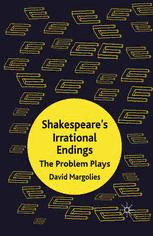
Shakespeare’s Irrational Endings: The Problem Plays PDF
Preview Shakespeare’s Irrational Endings: The Problem Plays
Shakespeare’s Irrational Endings AlsobyDavidMargolies CHRISTOPHERCAUDWELL:MarxismandCulture(editedwithLindenPeach) CULTUREANDCRISISINBRITAININTHETHIRTIES(editedwith JonClark,MargotHeinemannandCaroleSnee) THEFUNCTIONOFLITERATURE:AStudyofChristopherCaudwell’s Aesthetics GREENEINCONCEITbyJohnDickenson(editedwithDonaldBeecher) HEARTOFTHEHEARTLESSWORLD:EssaysinCulturalResistancein MemoryofMargotHeinemann(editedwithMaroulaJoannou) MONSTERSOFTHEDEEP:SocialDissolutioninShakespeare’sTragedies NOVELANDSOCIETYINELIZABETHANENGLAND SCENESANDACTIONS:UnpublishedManuscriptsofChristopherCaudwell (editedwithJeanDuparc) WRITINGTHEREVOLUTION:CulturalCriticismfromLeftReview Shakespeare’s Irrational Endings The Problem Plays David Margolies EmeritusProfessorofEnglish,Goldsmiths,UniversityofLondon,UK Palgrave macmillan ©DavidMargolies2012 Softcoverreprintofthehardcover1stedition2012978-0-230-27761-8 Allrightsreserved.Noreproduction,copyortransmissionofthis publicationmaybemadewithoutwrittenpermission. Noportionofthispublicationmaybereproduced,copiedortransmitted savewithwrittenpermissionorinaccordancewiththeprovisionsofthe Copyright,DesignsandPatentsAct1988,orunderthetermsofanylicence permittinglimitedcopyingissuedbytheCopyrightLicensingAgency, SaffronHouse,6–10KirbyStreet,LondonEC1N8TS. Anypersonwhodoesanyunauthorizedactinrelationtothispublication maybeliabletocriminalprosecutionandcivilclaimsfordamages. Theauthorhasassertedhisrighttobeidentifiedastheauthorofthis workinaccordancewiththeCopyright,DesignsandPatentsAct1988. Firstpublished2012by PALGRAVEMACMILLAN PalgraveMacmillanintheUKisanimprintofMacmillanPublishersLimited, registeredinEngland,companynumber785998,ofHoundmills,Basingstoke, HampshireRG216XS. PalgraveMacmillanintheUSisadivisionofStMartin’sPressLLC, 175FifthAvenue,NewYork,NY10010. PalgraveMacmillanistheglobalacademicimprintoftheabovecompanies andhascompaniesandrepresentativesthroughouttheworld. Palgrave®andMacmillan®areregisteredtrademarksintheUnitedStates, theUnitedKingdom,Europeandothercountries. ISBN978-1-349-32555-9 ISBN978-1-137-03104-4(eBook) DOI10.1057/9781137031044 Thisbookisprintedonpapersuitableforrecyclingandmadefromfully managedandsustainedforestsources.Logging,pulpingandmanufacturing processesareexpectedtoconformtotheenvironmentalregulationsofthe countryoforigin. AcataloguerecordforthisbookisavailablefromtheBritishLibrary. AcatalogrecordforthisbookisavailablefromtheLibraryofCongress. 10 9 8 7 6 5 4 3 2 1 21 20 19 18 17 16 15 14 13 12 Contents PrefaceandAcknowledgements vi NoteonTexts vii 1 Introduction 1 2 All’sWellThatEndsWell 13 3 MuchAdoAboutNothing 36 4 MeasureforMeasure 56 5 TheMerchantofVenice 86 6 TroilusandCressida 112 7 Othello 138 8 Conclusion 162 Notes 174 Bibliography 177 Index 181 v Preface and Acknowledgements The Problem Plays, in my years of teaching Shakespeare to English and drama students, were always awkward. With the histories, the comedies and the tragedies, students knew where they were and theyknew (or thoughttheyknew) whythe charactersacted as they did. But the Problem Plays had actions, the endings in particular, whereanswerstoquestionsaboutmotiveseemedunsatisfactory.This madetheplaysdisturbing–nothugelydisturbingonnightmarepro- portions but producing an uncertainty that lingered. Why did they end like that? In the other plays the playworlds appeared to con- taintheanswers:wecouldlookatthemotivesofthecharactersand we could judge the consequences of their behaviour. But the Prob- lem Plays seemed to lack any stable connection between cause and effect;theyhadtoomanyarbitraryelements.Arbitrarinessisaresult of the author’s intentions, not those of the characters; Shakespeare must have intended the disturbance. Naturalistic understanding of theplayworldcouldnotexplain thesituation.Ifoundmyself cross- ing into territory everybody has been warned against: we cannot know Shakespeare’s intentions – don’t go there. Treating the plays asstructuresdesignedtoproduceemotionalresponseinanaudience I found to be a fruitful approach – the plays started to make sense. TheProblemPlaysarestillawkwardbutInowadmiretheirenormous skilland,notboundtonaturalism,IenjoythemmorethanIhadever imagined.Ihopethisbookcanalsomakereaders’experienceofthe playsmorepleasurable. Iamgratefulforthetoleranceofallmyfamilyinputtingupwith my distraction from concerns of daily life over the last couple of years.IalsowishtothankCushlaBrennanforherhelpfulcomments on the Measure for Measure chapter and Leonard Goldstein for his criticismofthechapteronTheMerchantofVenice.MostofallIthank SandraMargoliesforhercontinuingexpertcriticismandwiseadvice, andforherpatienceinhavingtolivewithsomeoneelse’sdeadlines. Thisbookisdedicatedtoher. DavidMargolies vi Note on Texts The editions of Shakespeare plays used in the different chapters are asfollows: All’s Well That Ends Well (1994) ed. Susan Snyder (Oxford: Oxford WorldClassics) Much Ado About Nothing (1981) ed. A. R. Humphreys (London: Arden) Measure for Measure (1994) ed. N. W. Bawcutt (Oxford: Oxford WorldClassics) The Merchant of Venice (1998) ed. Jay L. Halio (Oxford: Oxford WorldClassics) Troilus and Cressida (1984) Kenneth Muir (Oxford: Oxford Shakespeare) Othello(1968)ed.KennethMuir(Harmondsworth:Penguin) Hamlet (1982)ed.HaroldJenkins(London:Arden) KingLear(1972)ed.KennethMuir(London:Arden) References to other Shakespeare plays are taken from Stanley Wells andGaryTaylor(2005)TheOxfordShakespeare,2ndedition(Oxford: Clarendon) vii 1 Introduction AfewofShakespeare’splays–notquitetragedies,notquitecomedies, neither histories nor romances – were quarantined in the late nine- teenthcenturyinthecategoryofProblemPlays.1TroilusandCressida, All’s Well That Ends Well and Measure for Measure, the conventional group,wereidentifiedasProblemComedies,butTroilusandCressida certainly was not a comedy and the comic quality of the other two was constrained by their bitterness. They were not felt to have suf- ficient similarity to constitute their own positive category and were rather an ‘any other’group.Changes in criticalapproaches thatfol- lowedmajorchangesinsocialattitudesinthelastcenturyrevivified interest in the plays. New relevance and new meanings have been found in the texts. The conventional group of three has also been recognized as sharing significant characteristics with a number of other plays, The Merchant of Venice and Much Ado About Nothing in particular,andtothem,asIwillargue,Othelloshouldalsobeadded.2 Theenvironmental,economicandsocialproblemsthathavereached crisis point in this century, and the political structures that seem inadequate to deal with them, the widespread corruption in high places and the deluge of political spin, have had their effect on the arts and given the Problem Plays a new attractiveness. Shakespeare does not preach, he does not confront; he is neither an Edward Bond nor a late Pinter, but he does pose contradictions. These con- tradictions have always been there in the plays, but now people’s experience of the gap between official rhetoric and social reality makesthemimportant.Theattractionofthesesixplaysdoesnotlie in any answers Shakespeare provides; it is the excitement of seeing 1 2 Shakespeare’sIrrationalEndings in the theatre a relevant and witty response to the disintegration of societyaroundus. Contradiction is fundamental to the nature of drama, and all Shakespeare’s plays could be said to deal with it. ‘Drama, by def- inition,isdialogical,itisthemeetingpointofoftenconflictingatti- tudestoachosensubject’,AlexanderShurbanovandBoikaSokolova point out. In the Problem Plays these contradictions are created in such a way that they cannot be resolved. In the words again of Shurbanov and Sokolova, ‘most dramas, like most artistic products ingeneral,strivetotranscendthisdialogicalstatusandattainacon- clusive synthesis of attitude and meaning. Shakespeare’s drama is rather exceptional in that it does not seem to strive towards any such final transcendence, a peculiarity defined by the tradition of liberal humanism as the poet’s proverbial elusiveness’ (Shurbanov and Sokolova, 2001, p. 17).3 The major Soviet Shakespeare critic AlexanderAnikstsaid,‘Shakespeare’splaysarenearlyalwaysproblem plays, and not just the ones which we normally call the “problem plays”’ (Anikst, 1989, p. 179). All the plays necessarily have some conflictortherewouldbenoplotbuttheplaysIincludeinthecate- goryunderdiscussionhavecontradictionsthataremorethansimple conflicts. They go beyond oppositions of subject matter; they are contradictionsbetweentheformandthecontentandtheyarethere- fore impossible to resolve. They are most obvious in the endings of playswheretheformhasledtoaudienceexpectationswhichareful- filled at a formal level but, in terms of the content, are frustrated. Shakespeare’scomediescommonlyendinmarriages,bydefinitiona happyform,butthemarriagesoftheProblemPlaysareforthemost part not at all happy. Thus the happy form is filled with a dubious content; form and content are in contradiction. The endings pro- duceemotionalresponsesthatarepositiveandnegativeatthesame time, not the one and then the other. Part of the effectiveness of Shakespeare’sconstructionisthatthesecontradictionscannotberea- soned away or balanced out as a mediocre relationship. They arise from the same event but are attached to different aspects (the form and the content) and thus exist effectively in different dimensions. Thenearestparallelformeisopticalillusions–forexample,thedraw- ingoftwostackswhereone’sperceptionofthevisualkeepschanging, asintheFigureopposite.
